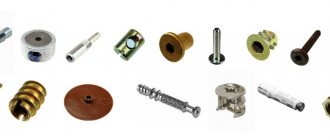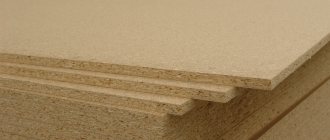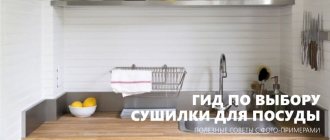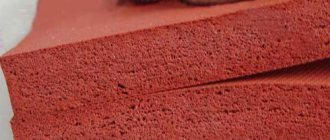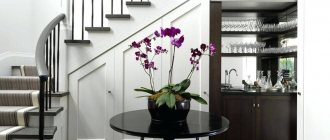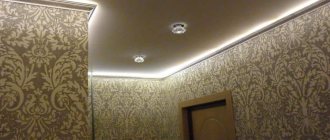Today, in the field of electrical engineering, modular electrical equipment dominates everywhere, replacing all previously disparate standards in sizes and installation methods, and offering uniform installation rules. Of course, this approach has many advantages, which makes working with such equipment as efficient, safe and fast as possible.
Since modular equipment is usually installed in special electrical cabinets and panels, these products must also provide the possibility of their convenient and compact placement. It was for this purpose that a single format was developed for panels and cabinets, which became the din rail.
Equipment on DIN rail
: reliable circuit breakers and residual current device (RCD) for mounting on a DIN rail
: AC/DC-DC voltage converters in a design for mounting on a DIN rail
For fastening electrical installation equipment
Modern manufacturers of electrical equipment already provide for the presence of a DIN rail in the switchboard. However, if necessary, it is quite easy to install it in any desired place. For this purpose, the profile of the rail is perforated with holes, thanks to which it can be attached to the plane with bolted connections or self-tapping screws. You just need to take into account the width of the machines that you will mount on it in advance, before installing the rail, so that they don’t feel “crowded”! It is better to cut a DIN rail with a grinder, but a hacksaw can also handle this.
Modern apartments are full of electrical appliances and all sorts of devices, so an electrical panel can occupy a wall area of about a square meter, accommodate a meter, a dozen circuit breakers, a zero operating and protective busbar and other important elements. But when they are compactly “attached” to a DIN rail in a secluded place, the interior of the apartment is not disturbed and no inconvenience is created for residents.
You have secured the tape, now you need to “attach” all the pre-prepared devices to it. In the modern world of electrical engineering, they are fortunately unified. And since all the elements of modern automation are adapted for DIN rails, it is very easy to “seat” them on it - press the sponge on the machine with a flat screwdriver, then lightly move, click - and that’s it, the machine is in its place. It only takes a few seconds to install one module; it’s not like installing screws into a wall!
By the way, it is much easier to maintain such a line of instruments and devices. To replace the machine on standard DIN rails in electrical panels, you just need to loosen the screws securing the wires on the terminals to disconnect them, after which the device lock moves down and the machine is removed from the rail.
Our consultants will advise you on all the other details when choosing the DIN rail you need so much, and electrical installation will become simple, convenient and enjoyable for you, just like when constructing a ship from a children's set of LEGO elements. Good luck to you!
DIN rails are made from galvanized steel or aluminum. Some models are perforated along their entire length for ease of distribution into components of the required size.
By profile type
According to the shape of the profile, the slats are divided into the following types:
- Omega-shaped profile, which is the most popular. The products are used for installation of switchboards: installation of automatic protective devices, meters and other necessary devices. The jaws of the slats are curved outward. The width of the device is either 15 or 35 cm. The height of the jaws is made in three standard sizes - 5, 7.5 and 15 mm.
- The C-shaped rail assumes the presence of concave edges 15 mm high. This product is used for mounting hardware clamps and terminal blocks.
- The G-shaped profile is used less often than other slats. Used for installation of some models of devices imported from abroad. It is quite difficult to find a rail of this type in our country.
The ends of the G-type slats are concave inwards, one of them is shorter than the other - the height is 9 and 15 mm. The width of the slats is 32 mm.
By perforation
For its intended purpose, the DIN rail serves as a mounting rail, which is a profiled strip of steel. The horizontal platform in most types of slats is perforated with oval-shaped holes necessary for attaching the product at the point of its installation. The holes are located at a distance of 10-20 mm from each other.
Slats are also available without perforation, the installation of which requires preliminary marking and drilling of holes for fastening at distances in accordance with the required dimensions.
By manufacturing method
According to the production method, products are divided into:
- stamped;
- cast.
Cast slats are highly reliable and can withstand significant loads without losing their shape and properties from their impact.
According to the material of manufacture
Depending on the material used in the manufacture, DIN rails are divided into:
- steel, reinforced with a protective galvanic coating;
- aluminum, lightweight.
By other parameters
DIN rails are also available with reduced profile thickness and width. Other models have special notches, with the help of which the product is divided into pieces of the required length.
Application benefits
The main advantage of using DIN rails is the ease and convenience of installation of modular devices for various purposes in switchboards, regardless of their type of design.
Manufacturing materials and load characteristics
The material from which a particular DIN rail is made must be suitable for its purpose. This means that it is necessary to take into account the expected loads, depending on which steel or aluminum products are selected. The first of these samples are more durable in their structure and can withstand extreme loads with a minimum strip thickness of only 1 mm.
By critical or extreme loads we mean the situation when large devices such as frequency converters, powerful magnetic starters or three-phase power circuit breakers are mounted on the rail.
Aluminum slats are capable of “holding” maximum stresses of mechanical deformation only with a thickness of 1.5 mm. Accordingly, the range of power and protective equipment placed on them will be significantly limited.
Load characteristics
Because a typical DIN rail is manufactured as a profile product, it can withstand greater deformation loads than a metal plate of the same size. Typical load characteristics of DIN rails are standardized by current standards for a number of characteristics, including the type of metal. Aluminum strips are available in the following versions:
- 1 mm thick slats designed for installation of single modular devices: circuit breakers, RCD units, power modules;
- 1.1 mm strips, designed for installation of single devices placed in several rows;
- the same products, but with an indicator of 1.4 mm, designed for modular equipment of any class and weight.
All these products are cut into pieces of the required length before installation.
The kit may include steel slats with a thickness of 1.0 mm, the load capacity of which is similar to an aluminum rail with a thickness of 1.5 mm. They can withstand maximum loads without restrictions on weight and number of seats within the permissible size. In addition, manufacturers of switchboard equipment often equip distribution cabinets with non-standard profile rails.
What are they?
Types of din rails are determined by different installation conditions and profile capabilities, represented by the following classification:
According to the section configuration
The G-type is a "G" shaped rail where one curved end is shorter and lower than the opposite edge. It is rare to find such a profile on the domestic market, since it is designed for installation of equipment of European standards.
The C-type is symmetrical and more common. The edges of the rail are equally curved, which provides reliable fixation for terminal blocks and clamps of other devices.
Omega-type has a completely different cross-section, similar to the Greek letter “omega”: the ends of the bar are sharply bent in both directions from the rail, forming peculiar “ears”. This design is adapted to almost all electrical elements and devices.
According to the presence of holes for fastenings
Perforated ones have holes approximately every centimeter, which greatly simplifies the process of installing the slats.
- according to the material of manufacture:
- made of aluminum;
- made of stainless steel (more common).
What does it look like?
A photo of a din rail clearly makes it clear that it is an elementary mounting strip - a profiled metal strip, cast or with specially made holes for fixing to the surface.
The name of the bar was the abbreviation of the developer of the useful device - the German Institute for Standardization or Deutsches Intitut for Normung - abbreviated as “DIN”. There are other variations of the name: lath, strip, rail, tire and profile.
Nowadays, mounting plates are so popular that almost all electrical equipment, even at the production stage, is equipped with special clamps for mounting on a din, greatly facilitating the work of electricians.
Photo of din rails
Let's immediately start the conversation with what a DIN rail is and why it is called that. This device was developed by the German Institute for Standardization (Deutsches Institut fur Normung), which is why it received the short abbreviation DIN. Electricians may also call this rail a din rail because it has a similar shape. Next, we will look at the main types and sizes of DIN rails used in electrical installation work.
Today, DIN rails are distinguished by such technical characteristics as size, shape, material of manufacture and design features. The first thing to start with is the types of profiles, which can be:
As for dimensions, according to the GOST R IEC 60715-2003 standard, the width and height of the product can be as follows:
Please note that the omega din rail, also called TN-35 (common designation), can have three sizes, namely:
The length varies depending on the manufacturer. Most often they produce strips from 7.5 cm to 2 meters in length, which is quite enough for panels from 4 to 96 modules.
It should also be noted that the strips are perforated (with holes) and cast. The advantage of the former is simpler installation, because... Simply screw the steel strip through the prepared holes. The perforation pitch is usually 10-15 mm, which is quite enough for convenient installation. Cast (non-perforated) DIN rails are more reliable because... do not sag if many machines in the cabinet are mounted on them. By the way, modular machines are mounted on a DIN rail as follows:
Based on the material used, the slats are divided into aluminum and galvanized (stainless steel). In electrical work, the second option is most often used.
In addition, there are separate types of DIN rails, namely: deepened and reinforced. Each of them is used in its own special case.
All that remains is to watch the video, which clearly shows how to mount the machine on a DIN rail, and also what is the difference between product manufacturers:
Circuit breaker installation
Comparison of manufacturers
That's all I wanted to tell you about the types and sizes of DIN rails. Now you know what types of planks there are, how they differ from each other, and what they are actually used for!
Terminal markings
In a terminal block assembled from a large number of assembled elements, without appropriate inscriptions and designations, it is very difficult to find one or another connector.
This is inconvenient both at the initial stage when installing conductors and when operating a ready-made switchboard. In order not to get confused where which conductor is connected, special markings of terminal modules are used.
At the same time, manufacturers include different numbers in different bags. Be careful when purchasing. One can only contain numbers from 1 to 10, and the other can only contain numbers from 11 to 20.
Each package has its own item number and its own position in the catalog. There is also universal marking without numbers at all.
All necessary inscriptions on them are made independently using a marker. Instead of numbers, you can also select the letters L1, L2, L3, N, PE, etc.
But the designation of the terminal block does not end there either. Each large assembly can have its own name so that an outsider can easily navigate the diagrams.
For this purpose, there is one more component - terminal box marking holders. It is inserted into the same stoppers or clamps that have universal use.
By the way, there are types of stoppers that already have such a platform in their design.
DIN rail limiter - easy installation
I welcome all visitors to the “Electrician in the House” website. After the hectic holidays I decided to do a little work. Today I want to share one trick that will help make assembling electrical panels a little easier. The chip is called a metal limiter for DIN rail yxd10. Its essence lies in the rigid fixation of equipment installed on a DIN rail. That is, it fixes machine guns, ouzo, diffs and any other equipment exactly in the place it should be. This article presents a din rail limiter from iek.
What is the advantage of this device? Why is it even needed? In truth, I must say that these questions are asked not only by beginners, but even by some professionals I know who have been doing electrical installation for decades. The limiters do not affect the operation of the equipment; the shield will work correctly without them (if, of course, everything is connected correctly)
But with the help of limiters you can give the shield a certain aesthetic appearance, which in my opinion is very important during operation
When you assemble a shield, you want everything to look beautiful and neat. Modular equipment mounted on a rail must be positioned clearly in line. But it happens that I installed a dozen machines on a DIN rail, connected them, everything seems to be fine. But you look from the outside - everyone is skewed.
One went to the left, another to the right, the third down, in general, some went into the forest, some for firewood. And if there is not enough space in the shield, and the wires touch the equipment installed on the rail, then it’s generally tough, everything will look like after an explosion.
To be honest, it is very difficult to find a limiter for a DIN rail; I ran around all the stores in my city, but they are not there anywhere. Most likely this is due to their low demand. Store owners simply do not want to purchase goods that are not in demand. I had to order online. Luckily there are plenty of them there. You may have better luck finding them in stock.
I have not used yxd10 limiters before. I also found them out on one of the electrical forums - mastercity.ru. I decided to try it and did not regret it.
They are also very convenient to use when you install a small number of protective devices (two, three). For example, in floor panels, when you are replacing old Soviet machine guns with modern ones. I had one case when in a floor panel it was necessary to replace an old bag and two machines that went to the apartment.
Instead of a packet package, it was necessary to install one two-pole 25 A (input) circuit breaker, and instead of the old circuit breakers, two single-pole 16 A circuit breakers. All of them needed to be placed and fixed somewhere. How to fix them? Of course, you need to take a piece of DIN rail, attach it to the shield body, and then attach the machine guns to it. So I did. I come back half a year later, open the shield and am surprised. On the piece of DIN rail that I attached (it is about 10 cm long), someone thought of putting their machine guns, moving mine at the same time. Moreover, one of my machine guns jumped off and was practically hanging in the air.
I had to remove all this beauty, install a longer rail and fix my machines using limiters on the yxd10 DIN rail. After this, the machines don’t move, and no one will be able to move them.
How to secure machines with a limiter
How to fix machines on a DIN rail using a limiter. Everything is very simple. The limiter itself is made of galvanized steel and is shaped like a bracket.
It is fixed on the rail using a pressure plate, which rests against the rail when the screw is tightened. In order to fix the machines or any other equipment, we take the limiter, install it in the desired place on the panel and tighten the screw located on top. We have one reference point.
Then we install circuit breakers, ouzo, terminal blocks (everything that is needed for the panel design) on the DIN rail, and press them tightly against the limiter. Then we take the second limiter on the yxd10 DIN rail, press it to the outermost machine and tighten the screw. The module, which is located between these two stops, is securely fixed, does not move left or right, and certainly will not jump off.
Similar materials on the site:
- Shield for apartment hager cosmos
- Horror in the floor board
End insulator
Another important point is that the insulated part of the terminal should always be on the left, the non-insulated part on the right.
That is, the exposed contact part should be located on the right side. When the terminal block is assembled, most installers stop at this design. The wiring begins.
However, do not forget about one of the exposed sides. All manufacturers make their equipment so that it is protected from accidental contact with live parts.
Therefore, when purchasing terminals, do not forget about the insulated end caps.
They are rarely sold individually; you will have to buy a whole set in a bag. Although often the entire assembly in the shield may require no more than 3 pieces.
Technically, such a product is called an end insulator. With a slight movement of the hand, it snaps into place thanks to its protruding parts.
End insulators can also be produced in various colors. But what if you don’t have end insulators, but you need to insulate the last right terminal?
The easiest way out is to place an additional empty terminal nearby. There is no need to connect wires to it. Although she will be naked, she will be without tension.
Or forcefully remove all metal insides from it. Another option is to use the ground terminal as the outermost terminal.
Let's make a project
It is better for a non-professional to do this when all the wires have already been laid and all the circuits have been taken into account. At the development stage, we must create working drawings for ourselves, according to which subsequent work will be carried out, and also find suitable specifications for components and accessories.
Consumer accounting, group creation
You need to start by compiling a complete list of consumers, if this was not done during installation of the wiring. This will not include the iron or sconce in the hallway, but each wire coming to the switchboard, which must be recorded and designated with a number.
Residential power supply systems follow the same principles and are therefore similar to each other. The power sockets of each room are powered separately and the lighting of the rooms is separately powered. Some household appliances do not connect to junction boxes; their wires go directly to the panel. This is not always explained by their increased power, like that of an electric stove, for example. Isolation may be a consequence of increased protection requirements (the boiler must be connected through a very sensitive RCD), or the need to turn off the device locally (an air conditioner for maintenance).
Sockets for each room must be powered separately
So, here is a typical list for a modern three-room apartment:
- sockets in the bedroom;
- sockets in the living room;
- sockets in the nursery;
- sockets in the bathroom;
- sockets in the kitchen;
- sockets in the corridor and hallway;
- connecting a washing machine;
- boiler connection;
- air conditioner connection;
- connecting an electric stove;
- lighting in the bedroom;
- lighting in the living room;
- lighting in the nursery;
- lighting in the kitchen and bathroom;
- lighting in the corridor, hallway and balcony.
Of course, if each circuit is “put” on its own machine and run through an RCD, it will be both more reliable and more convenient. But issues of compactness and efficiency are also important. We can combine some of the circuits listed above if the load is moderate and separate automation is not needed. For example, points 1 and 2, combinations 11+12+13 and 14+15 are also possible.
After combining, we transform the list into a simple table, where we will then enter data on the ratings of machines and RCDs.
Drawing up an electrical panel diagram
An important step in installing an electrical panel is creating its diagram. There are several explanations for this. Let's say, if you plan to repair or modernize the wiring in your apartment in the future, using the diagram you can quickly establish what each machine and part in the panel is responsible for. You will also need the diagram when accepting work as an electrician. In addition, connecting wires with such a diagram on hand is much easier. You can either draw it manually or in specialized programs, and then print it.
The electrical circuit is created in several stages. The first step is to find out what kind of electrical system is in the house, then divide all points of electricity consumption into several categories. After this, based on the existing data, a shield diagram is created
It is extremely important that the diagram used symbols, which are described in detail in GOST 21.614 “Conventional graphic images of electrical equipment and wiring in the original”
So, as mentioned above, all work begins with determining the power supply and grounding system in the apartment, since the connection of the panel will depend on this. You can find out by looking at the sign on the floor or by going to the housing office. Often, three systems TN-C, TN-S, TN-C-S are installed in residential buildings.
It is worth immediately noting that the first system was created according to old GOST standards and was used in houses that were built before 1998. The TN-C system is represented by two-core copper or aluminum wiring. A three-phase cable (L) with one conductor PEN, in which ground and neutral were combined, went to the floor distribution board. The last two systems are used in modern homes. A three-core copper wire is laid in the apartment, and a cable with three phases (L), neutral (N) and PE ground (S) is connected to the switchboard.
Installing a circuit breaker is easy
Circuit breaker installation can be divided into three parts:
- DIN rail fastening;
- Installation of a circuit breaker;
- Connecting the circuit breaker.
DIN rail mounting
In a new electrical panel or electrical box, the DIN rail is attached to ready-made places using self-tapping screws or bolts.
To install a DIN rail in an old floor panel, you need:
- Drill two holes in the metal platform of the shield;
- Cut threads into them;
- Secure the DIN rail with two bolts.
In the new floor panels, special perforated racks are already installed for fastening DIN rails, and fastening the DIN rails is not difficult.
Circuit breaker installation
After installing the DIN rail, we proceed to installing the circuit breaker.
- Prepare the circuit breaker and a long screwdriver;
- Pull the latches down and slide the circuit breaker onto the DIN rail;
- Release the latch. It should catch on the DIN rail.
A three-phase circuit breaker is installed in a similar way.
Circuit breaker connection
- To connect the circuit breaker, unscrew the screws of the upper and lower terminals;
- Insert pre-protected wires into the clamps;
- Tighten the clamps firmly, but not too enthusiastically.
The household series of switching equipment has another name - modular. The reason for this is that all circuit breakers, switches, and RCDs are assembled from modules of the same width. Their overall dimensions are approximately the same.
An important property of the modular series equipment is that its mounting is unified. Let's remember how old circuit breakers were attached to the surface. To do this, it was necessary to drill holes, sometimes even cut threads into them. And also use fasteners: screws, nuts, washers. Not only is this inconvenient, but it is also unsafe. In an electrical panel, part of which is energized, replacing the circuit breaker is carried out with a certain degree of risk. A dropped screw can short-circuit a phase to the housing and cause a short circuit. And both an amateur and a professional electrician can drop it.
No screws are required to fasten electrical equipment of the modular series. All of them are installed on a standard metal strip. It's called a din rail, let's figure out what it is.
The abbreviation DIN comes from the abbreviation of the name of the German Institute for Standardization, Deutsches Institut fur Normund. Strictly speaking, this abbreviation is used not only to designate rails, it is used in other areas to mark standard connectors, fastener parameters, and so on.
Terminal retainer or stopper
After installing the terminal on the rail, it must be fixed in place. Otherwise, when tightening the screws, the terminals will move apart in all directions.
In this case, you will need an end stop, holder or clamp, depending on what you call it. At least 2 pieces of such end clamps are needed for one assembly.
If there are many terminal blocks in a panel on one line, such stoppers can be used as separators. The more difficult it is to snap into place such a latch, the more reliably it performs its function.
In order to remove the end stop or the terminal itself without damaging it, carefully insert a screwdriver into the upper part, lift the product and pull it out without breaking the individual plastic parts.
End clamps, even from the same company, can be produced in various types:
- self-latching
- for screwdriver (BAM from ABB)
What sizes can DIN rails have?
All DIN rails have received standard sizes; they are never produced differently. Dimensions are determined according to the following state standard GOST R IEC 60715-2003, the width in this case can be:
It is worth noting that the omega din rail can have three sizes, because it is universal and is used everywhere. Find out how to take readings from a two-tariff meter.
The minimum length of the DIN rail is 7.5 cm and can accommodate one circuit breaker. The maximum is 2 meters, this length is enough to install 4 shields.
There are still slight differences in the manufacturing method; the planks can be:
- With holes.
- Solid.
The former make it possible to simplify the installation process; just screw the rail into the finished holes. The distance between the holes is 10-20 mm, which can be called optimal.
Cast (solid) ones are considered more reliable; even under heavy loads they do not bend. Even several machines can be installed on such DIN rails. This is how you can mount all devices during electrical installation.
Calculation of module width
The dimensions or dimensions of circuit breakers mounted on a DIN rail are usually calculated taking into account the following considerations:
- what is the total number of these devices planned to be installed in accordance with the wiring diagram used;
- what type of metering device (meter) and circuit breakers are supposed to be installed on it;
- what is the minimum gap between these devices that should be left.
If two automatic machines or RCDs can be mounted almost close to each other, the devices must be installed next to the electric meter at some distance (at least 1-2 centimeters).
When calculating the number of devices that can fit on a DIN rail, it is necessary to take into account their functional purpose. A two-pole circuit breaker has a larger width than a single-pole circuit breaker.
Features of installing a modular socket
Before installing each electrical panel, it is necessary to clearly determine the number and order of arrangement of all modular devices included in its composition. This is connected not only with the need to correctly draw up the general power supply diagram for the apartment, but also directly affects the choice of the switchgear housing.
Each modular element has a clearly defined size, which is regulated by the DIN43880 standard. In accordance with this document, the width of one module is taken to be 17.5 mm.
Depending on the power, today two types of DIN rail sockets are produced. They differ primarily in size.
The design of each such outlet is not fundamentally different from the design of built-in or surface-mounted models. This socket also has two working terminals, to which the phase and neutral wires are connected. Depending on the purpose, this device may be equipped with grounding contacts.
The only feature of such sockets is their clearly regulated shape and size, as well as the presence of a special latch that allows the product to be mounted on a rail.
The figure shows the two most common types of sockets designed for installation on a DIN rail. These models, in addition to their size, are distinguished by the presence of grounding contacts.
Socket without grounding
The width of this device is 1 module (17.5 mm), it is very compact. To install such an outlet you do not have to allocate a lot of space. A similar product is intended for connecting low-power consumers that do not require mandatory grounding, for example, a lamp or soldering iron. Models with rated current of 6 and 10 A are available.
Grounded socket
The socket is somewhat larger, having a width of 2.5 modules. It is equipped with grounding contacts and is intended to supply power to consumers whose metal parts of the housing must be grounded during operation. Such devices include, for example, hand-held power tools. Models are available with a rated current of 10 and 16 A.
Within the two varieties considered, there are a fairly large number of design options for sockets designed for installation on a DIN rail, which are designed to work in different conditions.
Most devices presented in electrical goods stores have a degree of protection of IP20, which is quite enough for installing them in a distribution panel.
As for decoding the designation of the degree of protection of electrical equipment IP, it is very simple. The first digit of the code corresponds to the diameter of the object from which this equipment is protected. The number 2 means that the device body is protected from penetration by objects with a diameter of more than 12.5 mm (human fingers or similar objects). The second digit of the numerical code indicates the degree of moisture protection. 0 corresponds to the absence of any protection against moisture.
If necessary, you can select a product that meets higher protection standards. For example, the Bemis 1/16A grounded socket, which has an IP44 degree of environmental protection, is designed for use in difficult conditions. The body of this product is made of durable plastic and is reliably protected from dust and water splashes. This makes it possible to actively use such sockets in manufacturing enterprises.
https://youtube.com/watch?v=7sz6sf-gUPg
Main purpose
The electrical panel consists of a number of modular devices (switches, automatic machines, indicators, sockets, etc.), each of which performs a specific function.
The panel socket is mounted in an electrical panel to allow connection of any electrical appliance to it during maintenance and repair of switchgear elements. Such an outlet is often used to connect electricity consumers located close to the switchboard. Often, during a control inspection of equipment, portable lamps are also connected.
The DIN rail socket is installed in buildings of various enterprises and office premises of large companies to create reliable electrical contact with the power plug of a device of any power during the arrangement of mock-up pavilions, test benches, etc.
Types of DIN rails
Due to the fact that DIN rails are often used to attach a modular socket, let’s look at their varieties.
Depending on the profile, there are several types of devices:
- Ω-type (Omega) or TH35. This type got its name due to the outwardly curved ends of the rail. In cross-section, the product resembles the letter Omega of the Greek alphabet. Another name was taken because of the unified size; its width is 35 mm. This type is the modern and most used type of device. In our country, it is classified as a rail for installation and fastening of low-voltage control and distribution devices. In addition, there is an auxiliary modification of the Omega type with a reduced profile width and thickness. It is not intended for mounting equipment, but is used to attach clamps in order to connect the wires of mounted devices.
- G-type. In appearance, the product resembles the letter G of the Latin alphabet - this is where it got its name. Its ends are bent into the inner part of the profile, one of which is smaller and lower than the other. It is used when installing and casing blocks for connecting wires, hardware clamps and terminals.
- C-type. Just like the previous type, this variety received its name due to the shape of the profile, the ends of which are bent inward and have the same length, reminiscent of the letter C. The scope of application of this type of slats is similar to the G-type. However, certain devices or additional devices that need to be installed in the panel are mounted exclusively on this form of rail.
In addition to their configuration, DIN rails differ in the material of manufacture:
- Steel with special coating. It is one of the main types of material. An additional coating layer protects the product from the negative effects of the external environment and prevents corrosion destruction.
- Copper.
- Aluminum.
Depending on the manufacturer, the devices may have holes or notches that allow them to be easily secured or divided into pieces of the required length.
Regarding the dimensions of the slats, it should be noted that they are standard:
- 35x7.5 mm is the most common option due to the fact that most electrical appliances are designed for installation using rails with these parameters;
- 35x15 mm - used in some areas of industry for installation and fastening of professional electrical installations;
- 15x5 mm – used for installation of non-standard mounted installations used in narrow industrial areas.
Sealing of terminals
When you have assembled the entire terminal block and connected the wires, the energy supply organization may require that all live parts be sealed so that later it will not be possible to make changes to the metering circuit.
For this purpose, plastic transparent boxes are used. In the fastening places where the “lambs” or nuts are tightened, there are slots for fishing line or wire from the seal.
